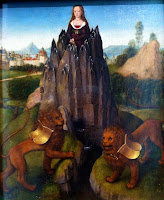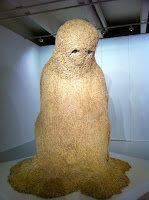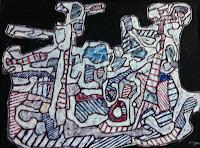FROM LAUSANNE TO LILLE - QUITE A CONTRAST
Then I learn that there is Paul Bril (1554-1626), Jan Wellens de Cock (around 1480-1527), Henri Bles (around 1500 and died around 1560) or Dick Bouts (around 1420-1475) and others... All names which were new to me. All followers of Bosch or certainly influenced by his work.
There are very few originals (Bosch) in existence today but there are certainly followers and the ateliers where students reproduced many of their own «images»....This is what the exhibition was all about.
 |
| Hans Memling 1480- Allegory to Chastety |
 |
| Follower of Jerôme Bosch La Vision de Tondal 16ème |
 |
| Joos de Momper (1564-1635) Allegory of autumn |
 |
| and to winter .... |
 |
| Peter Huys vers 1519 to 1581 La Tentation de Saint Antoine |
 |
| Follower J. Bosch 1516 Paradise |
 |
| Hans Mel de Bles |
 |
| Jan Mandyn and others Saint Christophe and the child Christ around 1540 |
So I learnt a lot. Looking at a picture with Marielle’s trained eye there were beasts I had not seen and monsters which jump to the eye and yet next to them, something pleasant comes up. One artist I did like and a discovery but I thought it was Joachim Patnir. However, when I studied Patnir’s work and this other painter, I knew it could not be the same master. The «unknown» was someone I really liked. Landscapes which seemed virtually modern.
 |
| Anonomous ? |
The exhibition is called «Fables du Paysage Flamand» «Myths or Fables of Flemish Landscapes». There are over 100 paintings and many discoveries. Religious scenes are of course of prime importance. Saint Antoine seems to be «tempted» in every possible way. (see above)I guess those who could not read or write were terrified by monsters or such temptations. Hell did not look like a nice place to be.
 |
| Pieter Brueghel Young and Old - Landscape 1569? - We know this well! |
 |
| Jan Brueghel - Jesus on the sea of Galillee around 1596 |
 |
| Atelier Jerome Bosch 7 deady sins 1500 around |
 |
| Simon de Meyle - Noahs Arch around 1576 |
 |
| Wolfe Von Lenkiewicz 2012 - Heaven is Made of Iron |
 |
| Hilary Berseth 2009 Programmed hive |
 |
| Charley Case birth and death of Babylone 1999 |
 |
| Add captionWim Delvoye Concrete mixer 2012 |
 |
| Wim Deloye - Tower 2008 |
 |
| Jacok Gautel - Tour of Babel - books 2006-2012 |
 |
| Jake and Dinos Chapman 2009 No Women No cry |
 |
| Samuel Rousseau 1971 - Brave Old new World projection |
Antoine Roegiers work was a breath of fresh air. Inspired from the 7 Deadly sins of Pieter Bruegel he presented each one as an animated video. Hybrid and fantastic creatures came to life in imaginary settings with repetitive movement and frankly a demoniac breeze made me smile and squirm. For the joy of it, go and have a look - http://www.antoineroegiers.com
 |
| Antoine Roegiers - The Seven Deadly sins" after Pieter Bruegel |
It was not finished - we wandered through Lille and saw a few of the FANTASTIC installations. This was the third in a series of festivities given as exhibitions or installations throughout the town. I had taken a photo when we were on our way in the morning of a framework in the main street and was lucky enough in the evening to catch it when it «lit» up for a few moments. Dentelle stellaire or Stellar Lace by a François Schuiten.
 |
| Stellar Lace in the morning |
 |
| And in the evening lit up |
It was the programme which had caught my eye with this marvelous «creature» I knew and couldn’t place.
 |
| All over town |
Nick Cave probably means an Australian singer for many of you and yet as soon as I saw his «sound suits» at the exhibition the following morning, I remembered that I had seen him as a dancer as well. In one of these moving suits. They are crazy and yet quite beautiful. Nick is American and had designed the suit for the opening parade of Fantastic which from the reviews, was just that. Fantastic.
 |
 |
 |
 |
 |
This series of installations would have seemingly terrified many a child. We arrived the following morning as the doors opened and there were groups of children of perhaps 4 to 6 years? Marielle was a little worried that such quirky installations would mean a sleepless night for parents. I wasn’t too worried. Sure there were skeletons and odd mythical animals around but Nick Cave’s costumes and some of the videos probably erased the fear of a mythical «Whispering Chamber» by Marnie Weber. I must admit that I did find this a little macabre.
 |
| Theo Mercie - A sad creature to greet us |
 |
| Theo Mercier 2010 And an invisible family to follow us |
 |
| And to taunt us |
 |
| And to daunt us |
 |
| A Whispering chamber to haunt us (Marnie Weber) |
 |
| Would you ride on "its back? |
 |
| A dinner guest ? |
 |
| Maybe not to ride.... |
 |
| Boo to you all |
There was one more stop. The L.A.M The Lille Metropolitan Museum of modern art. At Villeneuve D’Ascq.
 |
| From Lausanne |
The space is quite different from that in Lausanne and this time at least, there was a chance to admire some of the work or some of the sculptures without feeling the pressure of repetition. Despite this, I still could not appreciate Aloise even if there were only four or five of her works on display. There were sculptures though which I found admirable and a few paintings which were not, from my point of view, too oppressive.
 |
| Theo Wiessen corner of sculpture |
 |
| A little nicer than in the Whispering chamber |
The modern art collection is good with a room dedicated to cubism and others to Modigliani, surrealism and abstraction along with a room of Dubuffet’s work. Here too I felt as if a hammer had come down on my head. The room was too small to house all those paintings so after having taking a photo of one I like, I moved on fast. I wonder if this is why he was a collection of Art Brut? His own work in it’s abstract from can be pretty repetitive.
 |
| Dubuffet |
 |
| Modigliani 1918 - Roger Dutilleul - the first collector |
 |
| Modigliani 1908 |
 |
| Picasso Naked Mand 1908-9 - pre cubism |
 |
| Picasso |
 |
| In the Modigliani room : Attributed to Paola Zacchia 1530-1540 |
 |
| Modigliani - Moise Kisling 1916 |
 |
| Fernand Leger Femme avec Bouquet 1924 |
 |
| Eugene Nestor de Kermadec 1932 - Femme au bolero |
 |
| De Kermadec 1928 |
 |
| Add captionPicasso - Woman's head 1943 |
 |
| Gaston Chaissac - Forgotten woman 1960 |
 |
| Gaston Chiassac - personnage 1947 |
 |
| Annette Mesager 2003 |
The contemporary art is well spaced and the map of France (2000) by Annette Messanger is always fun to look at. Marielle pointed out to me that Corsica is always badly placed on a French map and especially here - it should be much further away from the mainland coast - touching Italy. Of course I thought - I had crossed over to Sardinia from Bastia and it seemed a stones throw away.
 |
| Picasso in the garden |




Commentaires